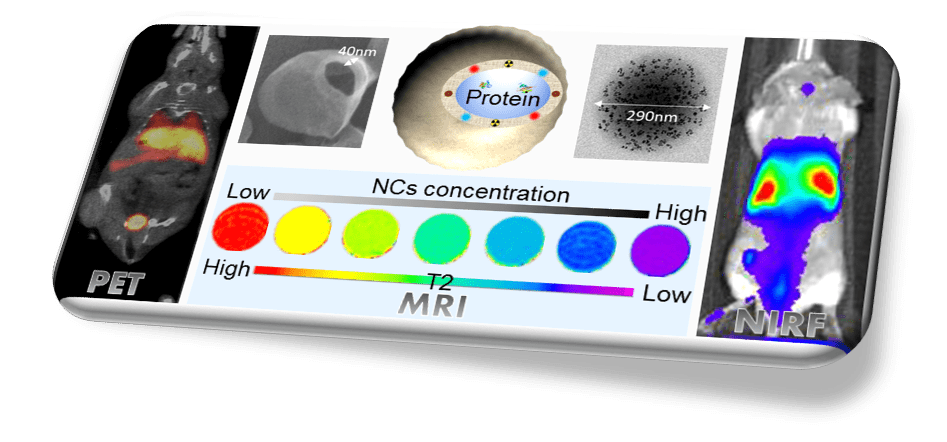
Hot off the press: paper published in Nanoscale!
New paper “PLGA protein nanocarriers with tailor-made fluorescence/MRI/PET imaging modalities” authored by Yajie Zhang and Anna Roig was published today in Nanoscale. Irene co-authored the article.
The study was co-led by Anna Roig from N&N Group and Anna Rosell from Vall d’Hebron Research Institute, and done in collaboration with CICbiomaGUNE and University of Artois. It is a part of a European project (MAGBBRIS) focused on preparing safe, biocompatible and biodegradable nanomaterials for biomedical imaging and brain repair after stroke.
The work involved synthesizing therapeutic nanocapsules with three contrast agents for three biomedical imaging techniques and studying their biodistribution. The approach allows including the contrast agents together or separately in the nanocapsules, without affecting their size or shape, nor interfering with the encapsulated therapeutic agent.
Nanocapsules are used for drug delivery of insoluble, highly sensitive, or multi-components drugs. Nanocapsules also protect the encapsulated drug from degradation, inactivation or clearance, and reduce its toxicity, if it is the case. Furthermore, nanocapsules allow the functionalization or modification of its surface, so contrast agents for biomedical imaging can be chemically attached, as is the case in this study.
The biomedical imaging techniques used in this study include magnetic resonance imaging (MRI), fluorescence (blue and near-infrared) and positron emission tomography (PET). All three are non-invasive diagnostic by imaging and experimental research tools that allow to visualize where the nanocapsules are in the organisms in real time.
Congratulations to the authors!
Abstract:
Developing multifunctional and biocompatible drug delivery nanoplatforms that integrate high drug loading capacity together with multiple imaging modalities while at the same time avoiding cross interferences is extremely challenging. Here, chemical modifications of poly(lactic-co-glycolic acid) (PLGA) to produce biocompatible nanocapsules (NCs) that incorporate multimodal imaging moieties for in vivo formulations are reported. The chemical synthetic routes to endow the PLGA with a magnetic resonance imaging (MRI) reporter, two fluorescence imaging probes and a positron emission tomography (PET) reporter are presented. Then a made-to-order modular integration of these imaging reporters into the shell of the PLGA NCs is successfully achieved without affecting the morphochemical properties of the nanocarrier or the drug loading capacity. Biodistribution of the NCs are monitored by MRI/PET/NIRF in vivo and the results from the different techniques analyzed comparatively. The viabilities of two different human endothelial cells in vitro show no toxicity for NCs concentration up to 100 μg mL-1. The morbidity of mice for 2 weeks after the systemic administration and the hepatic/pancreatic enzymes at plasma level show in vivo biosafety of the NCs. In summary, the new theranostic PLGA nanoplatform presented here shows versatile in vivo multimodal imaging capabilities, excellent biosafety and over 1 wt% protein loading.
Anna Roig, Nanoscale, new paper, new publication, PLGA, polymeric nanocapsules, Yajie Zhang

